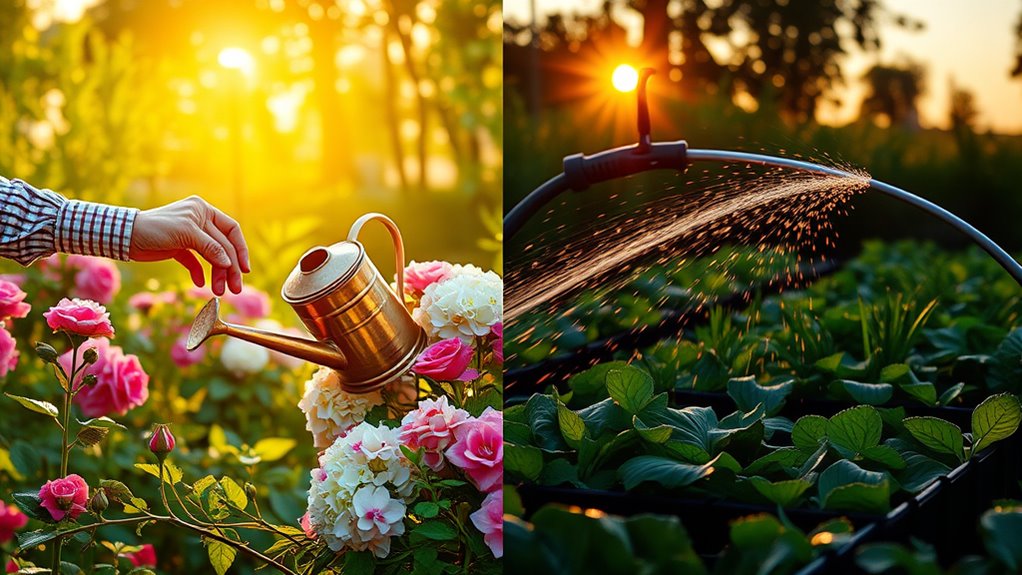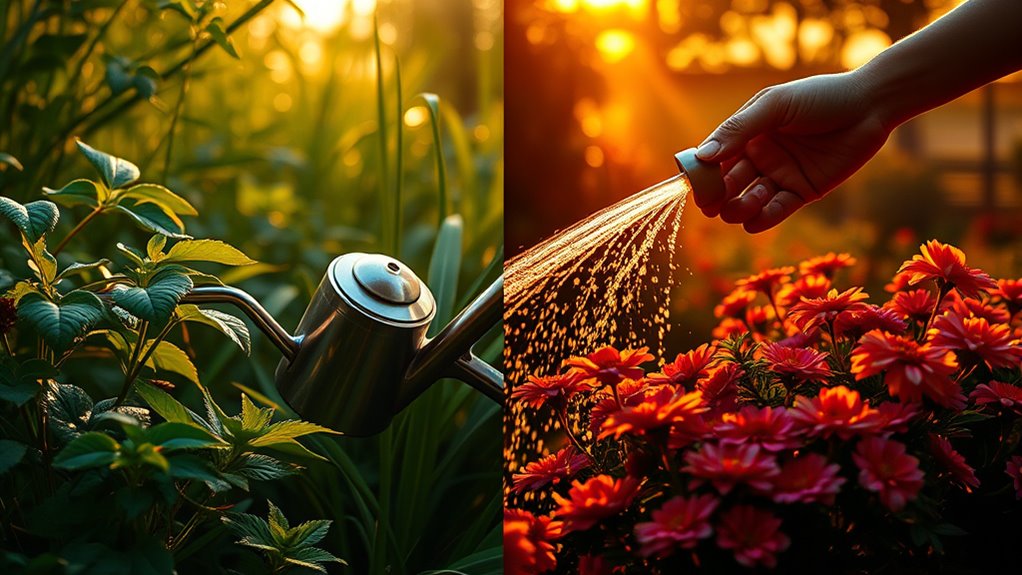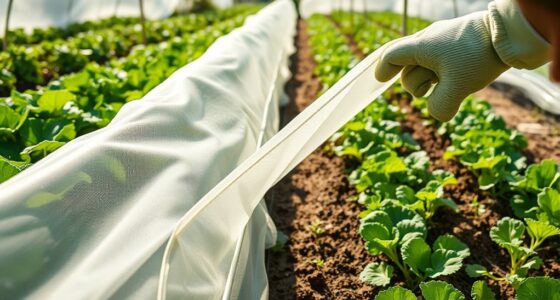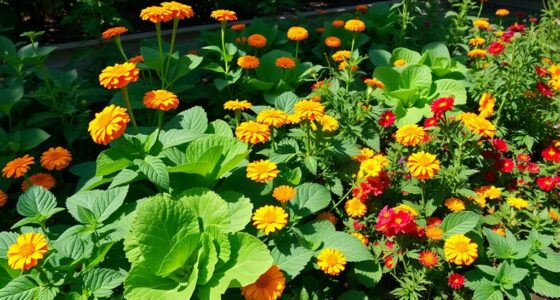Watering your garden in the morning is generally better because it promotes deep root growth, helps plants dry faster to prevent disease, and conserves water by reducing evaporation. Evening watering keeps leaves damp longer, increasing fungal risks and mold, especially in humid areas. It also may reduce water efficiency in hot climates. Choosing the best time depends on your climate and plant needs, so exploring more can help you optimize your watering schedule effectively.
Key Takeaways
- Morning watering promotes deep root growth and reduces fungal disease risk by allowing leaves to dry.
- Evening watering increases humidity and mold risk due to prolonged dampness on soil and foliage.
- Watering in the morning enhances water conservation by minimizing evaporation during the hottest part of the day.
- Evening watering may lead to plant stress and disease, especially in humid or cooler climates.
- The optimal schedule depends on climate, plant needs, and personal routine, with morning generally preferred for plant health.

A proper watering schedule is essential for keeping your plants healthy and thriving. When you develop a consistent routine, you help ensure your plants receive the right amount of moisture, which directly impacts their overall health. The timing of your watering—whether in the morning or evening—can make a significant difference in plant health and water conservation. Understanding the benefits and drawbacks of each approach allows you to make informed decisions that support your garden’s vitality while conserving water resources.
Watering in the morning is generally the preferred choice for many gardeners. During this time, the soil is cooler, and the air is less humid, which helps water penetrate deeply into the roots. When you water in the morning, you give your plants the moisture they need to start the day strong, promoting robust growth and reducing stress. Morning watering also allows excess moisture on leaves and stems to dry out during the day, lowering the risk of fungal diseases and other plant health issues. This approach is especially effective if you’re aiming to maintain healthy, resilient plants that can withstand the heat of the day. Additionally, watering in the morning supports water conservation because it minimizes evaporation. When the sun is not at its peak, less water is lost to the atmosphere, meaning you use your resources more efficiently and can extend the lifespan of your watering supplies.
Watering in the morning promotes deep root growth, reduces fungal risks, and conserves water by minimizing evaporation.
On the other hand, watering in the evening has its advantages. If you’re pressed for time or prefer to tend to your garden after work, evening watering is convenient. It allows the soil to absorb moisture overnight, giving plants a steady supply of water during the night and early morning hours. However, this practice can sometimes lead to increased risk of fungal infections and diseases because the leaves and soil stay damp longer, especially if the weather is humid or rainy. While watering in the evening might seem like a good way to ensure your plants are hydrated, it can inadvertently promote mold growth or root rot if the soil doesn’t dry out before nightfall. From a water conservation perspective, evening watering can be less efficient in hot, dry climates because the moisture may evaporate or be lost to dew instead of penetrating deeply into the soil.
Ultimately, choosing between morning and evening watering depends on your local climate, your plant’s needs, and your schedule. But if your goal is to maximize plant health and water conservation, morning watering is often the better option. It helps your plants stay healthier longer and makes the most of your water usage, ensuring your garden flourishes without unnecessary waste. By following a consistent schedule and understanding the benefits of each timing, you’ll support your plants’ growth and contribute to sustainable water practices.
Frequently Asked Questions
How Does Watering Time Affect Plant Disease Prevention?
Watering time impacts plant disease prevention by influencing soil moisture levels. Watering in the morning allows leaves to dry quickly, reducing excess moisture that fosters disease. Evening watering keeps foliage wet overnight, increasing disease risk. Proper timing helps with disease suppression, as it minimizes prolonged dampness. You should water early in the day to guarantee soil moisture stays balanced, promoting healthy growth and lowering the chances of fungal diseases.
Is There a Difference in Water Absorption Between Morning and Evening?
You’ll notice that watering in the morning benefits soil absorption and root hydration more effectively than evening watering. In the morning, the warm soil absorbs water quickly, ensuring roots stay hydrated throughout the day. Evening watering might lead to excess moisture lingering overnight, increasing the risk of disease. Consequently, watering in the morning promotes better soil absorption and keeps your plants’ roots well-hydrated without creating a damp environment overnight.
Which Watering Schedule Conserves More Water Overall?
You conserve more water by watering in the morning because it boosts watering efficiency and helps soil moisture retain longer. Morning watering allows plants to absorb moisture before the heat of the day, reducing runoff and evaporation. Evening watering can lead to excess moisture overnight, increasing the risk of disease. By choosing morning, you maximize soil moisture absorption and minimize water waste, making your watering routine more sustainable.
How Does Temperature Influence Optimal Watering Times?
Temperature critically influences ideal watering times by affecting evaporation rates and soil temperature. When it’s hot, watering in the early morning minimizes evaporation and allows soil temperature to stay cooler, helping plants absorb moisture better. Conversely, in cooler weather, evening watering can prevent rapid evaporation. You should adjust your schedule based on local temperatures to conserve water effectively, ensuring your plants get enough moisture without unnecessary loss.
Are Certain Plants Better Suited for Morning or Evening Watering?
Did you know that 70% of plant hydration occurs through morning watering? For most plants, watering in the morning is ideal, especially for those with high watering frequency needs, as it allows leaves to dry and reduces disease risk. However, succulents and desert plants prefer evening watering to prevent evaporation loss. Adjust watering times based on plant type to guarantee healthy growth and maximum hydration.
Conclusion
So, whether you choose morning or evening watering, remember that consistency matters more than the time. Some say morning watering boosts plant health by reducing fungal issues, but recent studies suggest evening watering allows plants to absorb moisture better overnight. Ultimately, listen to your plants and adapt to your schedule. With a little trial and error, you’ll find the perfect routine that keeps your garden thriving—because, in the end, your plants just want a little love and care.









